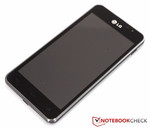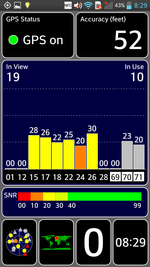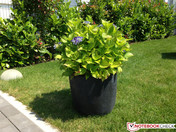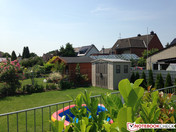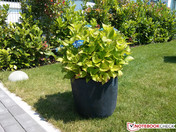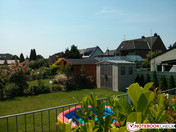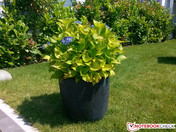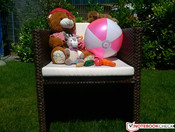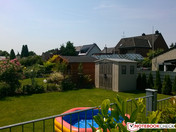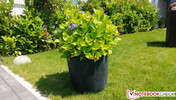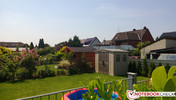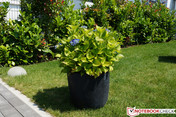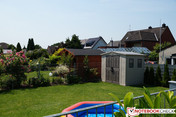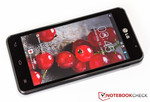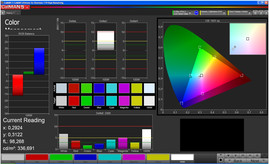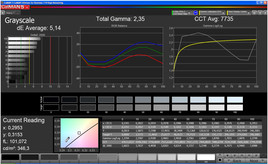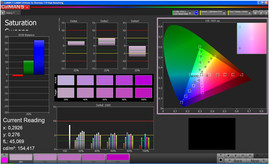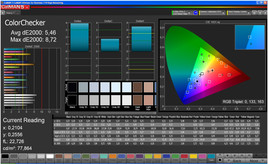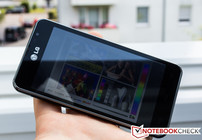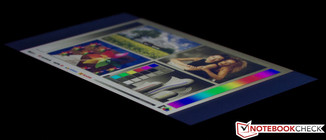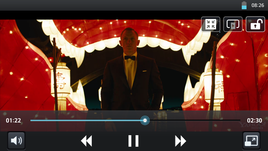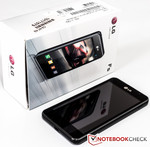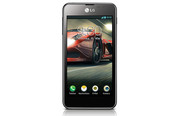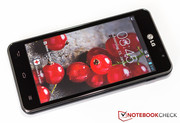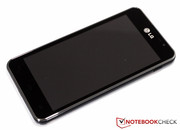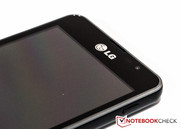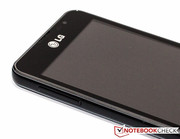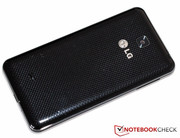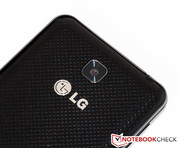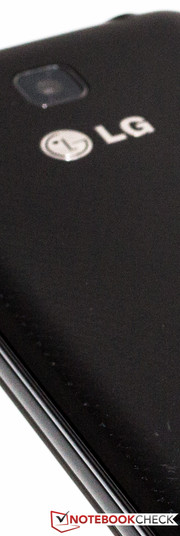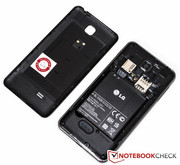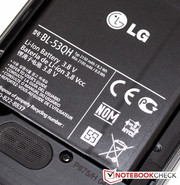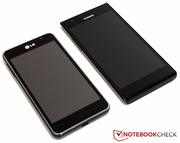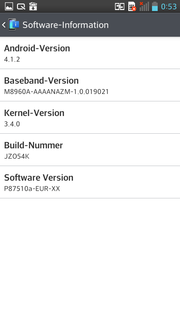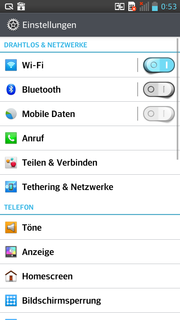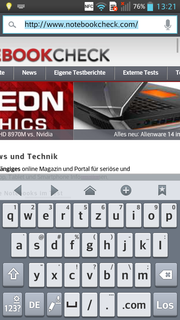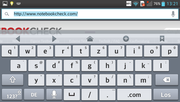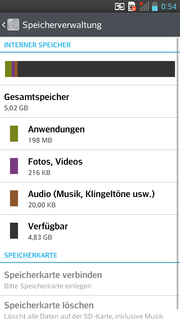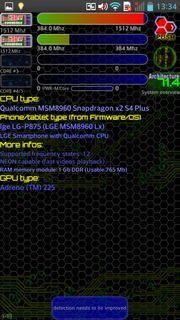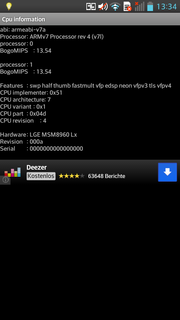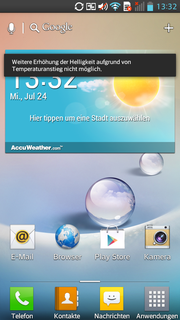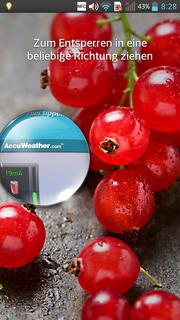Review LG P875 Optimus F5 Smartphone

For the original German review, see here.
The Optimus F5 is an LTE capable mobile phone with 4.3-inch display. Apart from fast wireless connectivity, the data sheet gives little information about further innovations. We think that the design is boring and lacks innovations. The inner components are also not brand new. Dual-core processors with 1.2 GHz and 1 GB are common now, even in very cheap mid-range models. However, an RRP of 399 Euros (~$528) cannot be called cheap. Can we detect anything special or is the Optimus F5 a pretender?
The case of the mid-range model is completely made from plastic. The removable back cover is glossy black and has a texture that resembles a chessboard. The slots for micro SIM and micro SD card are beneath it. The back is nearly pressure resistant, but, the F5 creaks from side-to-side twisting.
At 126 x 64.46 x 9.3 mm (~5.0 x 2.5 x 0.4 inches), every dimension is bigger than the Galaxy S4 Mini's – despite identical diagonals. With 131.1 g (~4.6 ounces), our test sample is also 24.1 g (~0.9 ounces) heavier than the S4 Mini. The Optimus F5 is available in black and white.
The four sides of the smartphone house the usual physical interfaces and buttons. External speakers can be connected to the 3.5 mm jack on the top side. The power button is on the right side towards the top. The opposite side houses the volume control at the same height. You can connect the Optimus F5 to a computer via its micro USB port on the bottom side. If the built-in storage capacity (8 GB) does not suffice your needs, you should consider buying a micro SD card. According to the manufacturer, cards with up to 32 GB are supported.
Software
Android 4.3 is already available – but not with the Optimus F5. The smartphone is two generations in the past and uses Android 4.1.2 (Jelly Bean). If and when a software update will be available, is not known at the moment. Since the mobile phone was only recently released, a future software update is a possibility.
Furthermore, the layout of the system settings was changed and an LG launcher preinstalled. Of course you can replace it by apps from the Google Play Store. Bloatware and several useful apps including "Backup", "SmartShare" and "Video Wiz" are preinstalled.
Communication & GPS
It is interesting that communication is possible via modern LTE band with theoretical download rates of about 100 Mbit/s. The Huawei Ascend P2 even achieves up to 150 Mbit/s with its LTE module. If LTE is not available or not included in your contract with your service provider, you can use UMTS. In home networks the smartphone can communicate via WLAN standards 802.11 b/g/n. We could not connect it with our WLAN router (Fritz!Box 7112, latest firmware), but this problem does not occur with other routers.
The GPS module works as expected. You can connect to satellites indoors and close to windows. An existing connection is stable without interruptions as long as visual contact to the satellites maintained.
Cameras & Multimedia
The test sample houses two cameras. The weaker model is above the touchscreen and features a maximum resolution of 1.2 MP. The main camera on the rear side features a 5 MP sensor and can record videos in Full HD (1080p). In addition, the main camera features a 4x digital zoom. However, you should only use it in exceptional situations.
To make comparison to other cameras easy, we shot some test pictures. The result of the rear camera is impressive. The 5 MP sensor, with relatively low resolution, achieves a decent result. Colors look realistic and the sharpness is satisfactory. In several pictures, the total brightness is lower. Therefore, heavy image noise is to be expected, if less ambient light is available (especially in closed rooms).
Accessories & Warranty
The scope of delivery is standard. Apart from a modular power adapter, an in-ear headset and quick guide manuals are included.
The warranty is 24 months for the smartphone, but only 6 months for battery and power adapter.
Input Devices & Handling
Apart from the capacitive touchscreen, the Optimus F5 features three touch keys below the display. The "keys" are primarily for navigating through Android. The most important input device is the 4.3-inch screen. It supports input from multiple fingers. It reacts quickly to inputs, but there is a delay when rotating the display content. The virtual QWERTZ keyboard just about takes up 40% of the screen in portrait mode. Navigation is possible without problems. If you rotate the device by 90°, only a little space remains. Now, significantly more than 50% of the screen is covered. If you also expand the navigation bar, the visible part shrinks to about 5 mm.
The glossy display of the Optimus F5 has a diagonal of 10.9 cm, which is 4.3 inches. A TFT IPS color display with 16.7 million colors is used. The resolution of the mid-range device is qHD (960x540 pixels). Given the display diagonal and the resolution, the pixel density is 256 dpi. The HTC One SV and the Nokia Lumia 720 with the same display size only feature 216 dpi.
The test sample achieves a maximum brightness of 337 cd/m² in the middle of the screen. The average brightness is 317.8 cd/m². Therefore, the Optimus F5 is about 20 cd/m² brighter than the Super-AMOLED screen of the Galaxy S4 Mini. However, the test device can hardly keep up with the extremely bright Lumia 720 (579.7 cd/m²). With 87%, the Optimus F5's distribution of brightness is also by 6 percentage points better than the S4 Mini's. However, you will hardly be able to recognize this. The black value of 0.31 cd/m² is acceptable for this display technology. Luminance and black value give a contrast of 1087:1.
| |||||||||||||||||||||||||
Brightness Distribution: 87 %
Center on Battery: 337 cd/m²
Contrast: 1087:1 (Black: 0.31 cd/m²)
ΔE ColorChecker Calman: 5.46 | ∀{0.5-29.43 Ø4.78}
ΔE Greyscale Calman: 5.14 | ∀{0.09-98 Ø5}
Gamma: 2.35
CCT: 7735 K
Further measurements with the CalMAN 5 software uncover a slightly blue tint and too weak red tones, which have a negative impact on color saturation. For example, "pink" looks too pale. You can easily recognize two significant deviations from the ideal gray levels. The screenshot of the gray level representation shows a significant deviation from the ideal curve.
Due to the low display brightness, it was to be expected that it is difficult to read from the screen in the sun. This is actually the case, but thanks to the high contrast, the result is just acceptable. The content is more or less legible if you turn or incline the device.
Work is primarily done by a dual-core processor from Qualcomm called Snapdragon S4 Plus MSM8960 with a clock rate of 1.2 GHz. The SoC is processed in 28 nm lithography. ARMv7 is used as platform and Adreno 305 as GPU. In theory, one gigabyte of RAM is sufficient for the smartphone, but a more powerful combination would be appropriate for an RRP of 399 Euros (~$528), e.g., the Galaxy S4 Mini's.
We ran several benchmarks to compare the actual performance to other devices. Let's start with the synthetic benchmarks. The Optimus performs decently in the Vellamo Mobile Benchmark 2.0 and only the Galaxy S4 Mini performs better in the "Metal" sub-rating. In all other tests, our test device is positioned behind the competition. Only the Galaxy S2 Plus with older hardware is always slower.
| AnTuTu v3 - Total Score (sort by value) | |
| LG P875 Optimus F5 | |
| Samsung Galaxy S4 Mini GT-I9195 | |
| HTC One SV | |
| Samsung Galaxy S2 Plus | |
| Geekbench 2 - 32 Bit - Total Score (sort by value) | |
| LG P875 Optimus F5 | |
| Samsung Galaxy S4 Mini GT-I9195 | |
| HTC One SV | |
| Samsung Galaxy S2 Plus | |
| GLBenchmark 2.5 | |
| 1920x1080 Egypt HD Offscreen Fixed Time (sort by value) | |
| LG P875 Optimus F5 | |
| Samsung Galaxy S4 Mini GT-I9195 | |
| HTC One SV | |
| Samsung Galaxy S2 Plus | |
| Egypt HD Fixed Time (sort by value) | |
| LG P875 Optimus F5 | |
| Samsung Galaxy S4 Mini GT-I9195 | |
| HTC One SV | |
| Samsung Galaxy S2 Plus | |
The browser-based tests have different results. In Google's "Octane" and "Google V8 Ver. 7", the test device cannot surpass the Galaxy S4 Mini, but performs better than the Nokia Lumia 720 Windows phone. In "Peacekeeper" and "Browsermark 2.0", the results are much higher than both competitors.
| Google V8 Ver. 7 - Google V8 Ver. 7 Score (sort by value) | |
| LG P875 Optimus F5 | |
| Samsung Galaxy S4 Mini GT-I9195 | |
| HTC One SV | |
| Samsung Galaxy S2 Plus | |
| Nokia Lumia 720 | |
| Browsermark - --- (sort by value) | |
| LG P875 Optimus F5 | |
| Samsung Galaxy S4 Mini GT-I9195 | |
| HTC One SV | |
| Samsung Galaxy S2 Plus | |
| Nokia Lumia 720 | |
| Octane V1 - Total Score (sort by value) | |
| LG P875 Optimus F5 | |
| Samsung Galaxy S4 Mini GT-I9195 | |
| Samsung Galaxy S2 Plus | |
| Nokia Lumia 720 | |
| Peacekeeper - --- (sort by value) | |
| LG P875 Optimus F5 | |
| Samsung Galaxy S4 Mini GT-I9195 | |
| HTC One SV | |
| Samsung Galaxy S2 Plus | |
| Nokia Lumia 720 | |
Our last benchmark, "AndroBench 3", evaluates the performance of the flash memory. Here the Optimus F5 achieves constantly very good values. The competition cannot keep up in reading or in writing.
Games & Videos
The performance in 3D games and playback of Full HD videos cannot be criticized. Modern Combat 4: Zero Hour and Need For Speed: Hot Pursuit are demanding games, but you can enjoy them as a pastime without problems. As Modern Combat 4 requires 2 GB, you might face problems during the installation. The Full HD trailers (1080p) are in the MKV container format and have a data rate of 6100 kBit/s.
Speech Quality
Our dialog partners confirmed that we were clearly audible in multiple test calls. We did not face unexpected interruptions and cannot complain about the maximum volume. However, the built-in speakerphone could be slightly louder - with increasingly better sound quality.
Temperature
We could not detect unusual high temperatures throughout our tests. This is reflected by the measured temperatures. We recorded average values of 34.6 °C and 34.3 °C (94.28 and 93.74 °F) (front side, rear side) with the Voltcraft IR-350. The competitors from HTC, Nokia, and Samsung are on par. If the processor is not demanded, the average temperatures fall by about 2 to 3 °C (to around 90 °F). Even the power adapter remains lukewarm under full load.
(+) The maximum temperature on the upper side is 39.6 °C / 103 F, compared to the average of 35.2 °C / 95 F, ranging from 21.9 to 247 °C for the class Smartphone.
(+) The bottom heats up to a maximum of 39.2 °C / 103 F, compared to the average of 34 °C / 93 F
(±) In idle usage, the average temperature for the upper side is 32.2 °C / 90 F, compared to the device average of 32.9 °C / 91 F.
Speakers
Similar to other smartphones, the mono speaker achieves an average result. The sound is acceptable below 65% of the maximum volume, but slightly tinny. At higher volumes, the sound is distorted and the audio experience uncomfortable. If you want to listen to music or watch a film at a louder volume, you should use the 3.5 mm jack.
Power Consumption
Even if no processor intensive tasks are run, the device requires between 0.6 and 1.5 Watts. The Galaxy S4 Mini and the HTC One SV need about 0.3 Watts less. Under load, the Optimus F5 requires between 3.4 and 4.1 Watts. Overall, the competitors perform similar here. The S4 Mini needs between 3.4 and 3.9 Watts and the One SV between 2.8 and 4.2 Watts. Only the Lumia 720 performs significantly better and needs about 1 Watt less than the Optimus F5 (Lumia 720: 3.1 – 3.3 Watts).
| Off / Standby | |
| Idle | |
| Load |
|
Key:
min: | |
Battery Life
With 2150 mAh (7.95 Wh) the capacity of the battery is more than up-to-date for the size of the smartphone (Galaxy S4 Mini: 1900 mAh). Therefore, we expect a decent battery life. We tested three scenarios to see whether this is actually true.
With the Stability Test app, we simulated full load with maximum display brightness and all wireless modules enabled. We were confused when the display started to automatically dim after a few minutes. As we tried to counteract, we received the message: "Because of the temperature rise, it is not possible to increase the brightness". During the test, the brightness fell down to 51% of the maximum. Therefore, you should take the result of the full load test with a pinch of salt. It can be reproduced, but not directly compared to other models. Much to our surprise the device already shut down after just above 3 hours despite the dimming. The idle result of 14 hours and 15 minutes is also not good. The Galaxy S4 Mini achieves nearly 20 hours in this scenario. We simulated Internet surfing with a script. With a brightness of about 50%, the Optimus once again, cannot keep up with the S4 Mini. With 8 hours and 4 minutes, the battery life is several hours shorter. Despite a powerful battery the Optimus F5's battery life is only modest.
Verdict
The first impression is often decisive and so it was with the LG P875 Optimus F5's. Already the first hands-on was boring. Design and haptics are not particularly innovative and the hardware can be found in many devices. It features an SoC from Qualcomm with a clock rate of 1.2 GHz and 1 GB RAM. In addition, the Optimus F5 comes with the usual wireless modules including LTE, NFC, and Bluetooth. Admittedly, the smartphone performs well and achieves satisfactory results in the benchmarks. Videos run smoothly and current 3D games do not pose a problem. Unfortunately, the battery life is only modest. The latter is also not improved by the "feature" which automatically dims the display when the device gets too hot.
What makes it even worse is the very high RRP of 399 Euros (~$528). At the time of testing the street price was 350 Euros (~$464) – which is still too high in our opinion. If you consider buying the Optimus F5, you should also consider the Galaxy S4 Mini. The latter is a significantly more attractive mobile phone of notably higher quality for a similar price.





